
Burn Awareness Week
Burn Awareness Week is February 6th through 12th. The Greater Manassas Volunteer Rescue Squad would like to take this opportunity to share a burn awareness and prevention message with our community. One of the most common injuries that can occur in the home are burns, and the places children get burned most is in the kitchen and the bathroom.
Did you know most children aged four and under who are hospitalized for burn related injuries suffer from scald burns (65%) or contact burns (20%)? A burn caused by something wet – like steam or hot water is called a scald. Contact burns may result in severe burn injury due to prolonged transfer of heat from an object to the skin. Burns are among the most painful and devastating injuries a person can live through. Young children have thinner skin than older children or adults. As a result, their skin burns more deeply and at lower temperatures.
KEY POINTS TO REMEMBER:
- Have a “kid-free zone” of at least three feet around the stove.
- Use burners on the back of the stove and turn pot and pan handles towards the back of the stove.
- Never drink or carry hot liquids while holding or carrying your child.
- When heating food in the microwave, use microwave safe cookware that allows steam to escape.
- Allow food to rest before removing from the microwave.
- Do not allow children to remove hot food or liquids from the microwave.
- Test food temperature before feeding your children. Never warm a baby’s bottle in the microwave.
- Keep a pan lid and dry potholders or oven mitts near you every time you cook.
- Make sure hot coffee pots and their cords are out of the children’s reach.
- Reduce water temperature. Set the thermostat on your hot water heater to below 120 degrees F. Check the temperature of bath water with your hand before putting your child in the bath.
- Don’t leave children alone in the bathtub. A child may turn on the faucet.
- Make sure that your child can’t reach hot appliances such as curling irons and hair dryers.
WHAT TO DO IF YOUR CHILD IS BURNED:
- Treat a burn right away by putting it in cool water. Cool the burn for three to five minutes.
- Cover burn with clean, dry cloth. Do not apply creams, ointments, sprays or other home remedies.
- Remove all clothing, diapers, jewelry and metal from the burned area. These can hide underlying burns and retain heat, which can increase skin damage.
- Blistered burns on the hands or face should always be checked by a health care provider.
Preventing a burn injury is always better than the pain and trauma of medical treatment afterwards.
References:
American Burn Association: www.ameriburn.org
Mayo Clinic: www.mayoclinic.org/healthy-lifestyle
FEMA: www.usfa.fema.gov
Regions Hospital: www.healthpartners.com/hospitals/regions
John Hopkins Medicine: www.hopkinsmedicine.org
Kids Health: www.kidshealth.org
